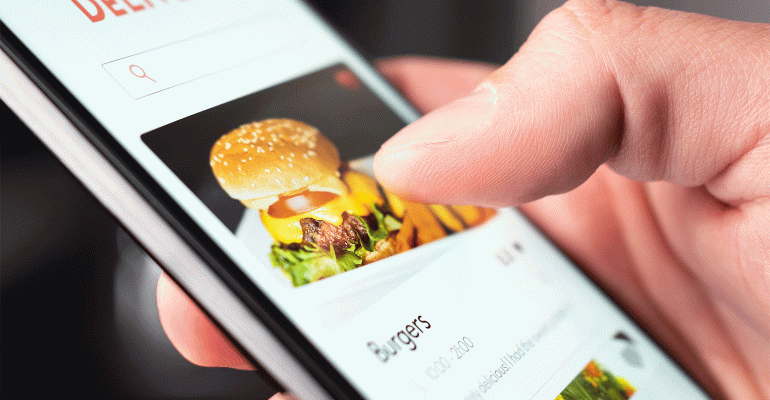The proliferation of mobile food ordering and delivery is showing no signs of letting up. The pandemic hastened a movement that was already in full swing with the ubiquity of mobile devices and Americans’ penchant for convenience. According to the State of 2021 Mobile Report, sessions inside food and drink apps grew by 105% in 2020, and a report from Sensor Tower found restaurant-branded app downloads jumped 91% in 2020.
Restaurants getting the mobile ordering experience right have the potential to boost order frequency, increase average order size, build brand loyalty and capture new customers — all contributing to year-over-year revenue growth. On the flip side, those coming up short may see diners ordering from the restaurant down the block or even lighting up contact center lines with questions and complaints.
With a growing list of restaurants and food delivery platforms offering apps and vying for diners’ dollars, it’s crucial to optimize the mobile ordering experience to ensure your restaurant’s app is capturing and retaining users and not driving them to the competition. A/B testing can provide you with the insights you need to do just that.
What’s to gain from A/B testing and feature experimentation
A/B testing and feature experimentation should be the guiding forces behind any restaurant’s or food delivery platform’s mobile strategy. With these tools, you can attain the data you need to make your apps stickier and improve the in-app experience.
A/B testing — where you compare two versions of something to determine which performs better — can take the guesswork out of what to optimize within your restaurant app. By letting real user data speak for itself, you can directly see the impact a change has on your app and move forward with the winning variation. Making continuous improvements will provide deeper insights into customer preferences and allow you to make updates that are aligned with what they have responded well to in the past.
Through feature experimentation, you can serve targeted messaging to your customers to create a personalized experience. If a customer hasn’t placed an order in a while, experiment with giving them a coupon or discount to see if it entices them to order again. Alternatively, you can customize specific messaging for customers who order frequently or recommend food items on your app’s homepage that are similar to what they have ordered in the past. All of these elements help create a personalized experience that can increase loyalty and repeat purchases.
The options of what you can test on your mobile app are practically endless. Anything from a small change like testing the color of a call-to-action (CTA) button to larger tests like the onboarding experience can have a big impact on conversions. Here are some tests to consider as you work to optimize your mobile app.
Onboarding
The onboarding process is the first interaction your users have with your mobile app. It’s crucial to create a great first impression and allow users to get started using your app as quickly as possible. To make your onboarding process more seamless and user-friendly, try experimenting with adding social sign-in options where customers can connect to their Google or Facebook accounts rather than manually entering all of their information. You can also test different onboarding flows, such as reducing the number of welcome screens a customer sees or changing the welcome message they receive once they have logged into your app.
Copy
Testing different variations of copy within your app is simple and highly effective. Some of the copy changes that can yield the greatest impact include headline text, CTA prompts and menu item descriptions. As a best practice for copy and all A/B tests, make sure to just run a single test at a time, so you can pinpoint the most and least successful changes.
This type of test is fast and easy to implement and it gives you insight into what kind of messaging your customers respond to the most. You can replicate certain words or CTAs that were proven to be successful in other parts of your app.
Imagery
People eat with their eyes, and running A/B tests can tell you which images resonate best, which can lead to more orders. Take Netflix as a case in point when it comes to image testing–the team A/B tests most movie title images, and reports that it sometimes leads to a 20-30% uptick in viewing.
Test different images for a certain dish and compare against sales data to see if it leads to an increase (or decrease) in orders. You can also test if a static image, carousel, gif or video performs better.
Filters
Search filters can help your customers get to what they’re looking for faster, and result in a better user experience. Try to implement different filtering options and see if that moves the needle for your app. You can experiment by adding filters for recommended items based on past orders, or by type of cuisines, price range or proximity to a customer’s location. Understanding the types of filters that users positively respond to can help inform the layout of your app.
Notifications
Data shows that, if they have opted into push notifications, users open an app 88% more than those who did not. There are many ways you can experiment with notifications to increase app launches, such as time of day, location or order history.
For instance, A/B test a lunchtime promotion to see if it’s more effective if it’s sent at 11 a.m. or noon. You could also deliver personalized notifications based on a user’s history. If they haven’t ordered in a while, try offering them an incentive such as a coupon to order again or, if they’re a frequent user, prompt them to refer a friend to receive a discount on their next order.
Payment flow
Having a smooth payment process is an absolute must because it’s the final step a customer takes before making a purchase. A case in point: our Taplytics team worked with Chick-fil-A to identify snags in its payment process, which led to a 6% increase in mobile payments and zero mobile payment-related support calls.
Popular tests to run on different aspects of your payment flow include A/B testing the point at which a payment method appears, the number of steps needed to complete the payment, the placement of elements on the app and add-ons to a user's order.
Start iterating
Every restaurant with an app wants to maximize its potential and, to do that, it’s imperative to constantly work to optimize it. The mobile channel is getting more competitive by the day in the restaurant world. By continuously making changes to your mobile app based on user preferences, you can transform it to specifically meet your users’ needs and wants–even if they don’t know what they are themselves. Never underestimate the impact of small UX and UI tweaks. As you continue to iterate, you’ll be working towards a better version of your app and reap the benefits of a more engaged and loyal customer base.
 Aaron Glazer is the CEO and co-founder of Taplytics, the most comprehensive feature management and experimentation platform for the modern enterprise. Digital leaders like Grubhub and Chick-fil-A use Taplytics to create a competitive advantage. Aaron grew Taplytics from a couple of friends in a basement to a Y-Combinator-backed powerhouse. Before Taplytics, Aaron was a strategy consultant at ZS Associates and he also worked in a management consultant role for Accenture.
Aaron Glazer is the CEO and co-founder of Taplytics, the most comprehensive feature management and experimentation platform for the modern enterprise. Digital leaders like Grubhub and Chick-fil-A use Taplytics to create a competitive advantage. Aaron grew Taplytics from a couple of friends in a basement to a Y-Combinator-backed powerhouse. Before Taplytics, Aaron was a strategy consultant at ZS Associates and he also worked in a management consultant role for Accenture.





